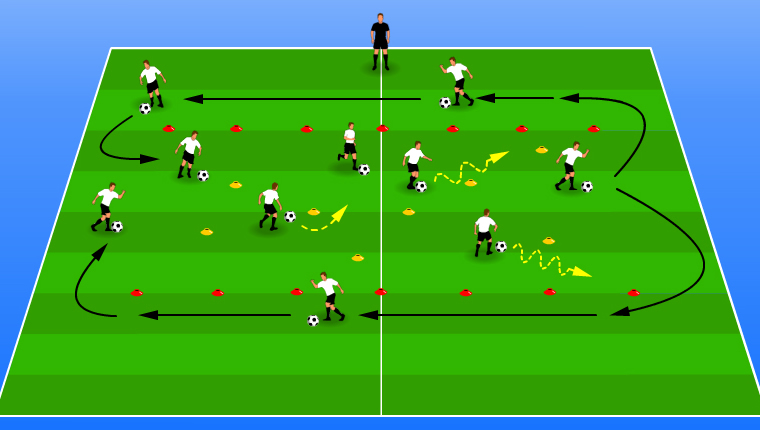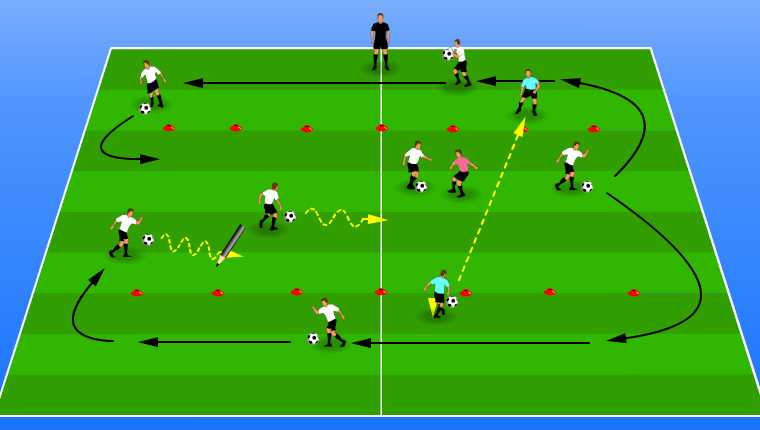Skills Corridor
- Author: Ian Knapp
- Age Group: U7 to U10
- Time: 30 minutes
Introduction:
This was a exercise I first saw on the FA Youth Module courses and it works really well for young players, with everyone getting lots of touches, lots of opportunities to try different skills, improving “ball mastery”, whilst also dealing with the traffic of other players. It also allows you to introduce passing, shooting and defending as progressions if you want.
Setup:
- Mark out a rectangular “corridor” area using cones, size dependent on number of players. 25x10 yards a good starting point.
- Scatter some different coloured cones randomly around the area.
- Players start at one end of the corridor, each with their own ball.
Basic Rules:

- Each player dribbles their ball from one end of the corridor to the other (left to right in the above diagram).
- Coach encourages players to try different things - turns, tricks, weaving side to side, changes of pace and direction, stopping the ball, toe taps etc.
- The scattered cones can represent defenders that the players have to “beat” with a drop of the shoulder, trick or change of direction or pace.
- When a player reaches the end of the corridor, they dribble their ball back round the edge to the start point and go again.
- When making their way back round the edge, players can have the challenge of keeping the ball in the air (if they are able) or bouncing it basketball style, throwing and catching it etc. Something different from dribbling.
Progressions and Variations:
The following diagrams show how you might progress the practice, but try your own progressions and see what works for your players:
Progression 1: Defenders and Passers

- The pink player in the graphic above has been introduced as a defender. His job is to win the ball from any of the dribblers. If he wins it, he can counter attack and try to run the ball back to the start point. You could then have him become the dribbler whilst the player who was tackled becomes the defender.
- We have also introduced a pair of passers (blue), with one on each side of the corridor. They have to pass the ball between themselves, across the corridor, avoiding the traffic of the dribbling players. Encourage them to move up and down the edges of the corridor, rather than staying still. Can encourage one touch passing, weaker foot passing etc. as progressions for them.
- Can introduce more defenders / passing pairs depending on numbers.
- Rotate players between roles regularly.
Progression 2: Shooting
- Introduce three corridors rather than one. Goal with a goalkeeper at the end of the central corridor. 2 x defenders (pink, above), who defend the 3 corridors.
- Players dribble down the corridors, shooting at the goal if they reach the far end. Up to 3 players can go at the same time.
- Defenders have to try and stop them by working as a team and deciding who to tackle. Both defenders can’t be in the same corridor at once.
- Every time defenders win a ball or the goalkeeper saves, they get a point. If attacker loses the ball, their turn is over and they return to the back of the line by going round the edge.
- For every goal scored, the attacking / dribbling players get a point.
- It can get chaotic if too many players go at once, so coach needs to manage this.
Remember, these are just ideas for progressions - there are lots of different options. Experiment and let us know if you have anything that works particularly well with your players so we can add it in.
Coaching Points (FA's 4 Corners):
| Technical | Psychological |
|---|
- Ball control (keep ball close, use left and right foot, inside and outside of foot)
- Turning with the ball
- Tricks and skills
- Passing
- Tackling (body shape, when to try and win the ball)
- Change of pace / direction to beat a player
- Look up before shooting
- Shots into corners / across the goalkeeper
|
- Decision making
- Awareness of where other players / opponents are.
- Don't worry about mistakes or if you're finding things hard - all part of learning
- Can you "try" new things and take risks?
- Be confident and positive!
|
| Physical | Social |
|---|
- Changes of direction
- Changes of pace (speed up, slow down)
- Shield the ball (use strength, body, arms up to protect the ball)
|
- Encouraging others and not being negative
- Communication
- Have fun!
|